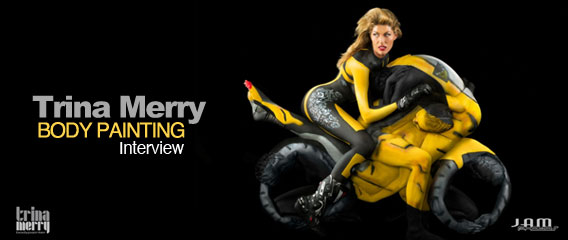Interview with Trina Merry Who Takes Body Painting to a Whole New Level
We’ve all done the double take. We see a photo of a beautiful woman wearing impossibly tight lingerie or swimwear. On second glance you realize that she’s not wearing anything but paint. We’ve all seen this concept executed well and, all too often, executed poorly. New York City based artist Trina Merry has taken the body painting art form to a completely new and unbelievable level. You’ve likely seen her work floating around the Internet as they are definitely worthy of a double-, triple-, and even quadruple take. Creations like her “Human Motorcycle Project”, her work with creating a Fiat out of nothing but human bodies and paint, and her recent graffiti camouflage installations have all impressed and wowed audiences and have earned her millions of views on the web. Trina was kind enough to take time out of her extremely busy and physically demanding schedule to talk to STC about her projects, her methods, and what keeps her passion burning.
Interview:
STC: Tell us a little bit about yourself. Do you have formal art training?
Trina Merry: Well, I’ve been drawing since I was two years old. I’ve always been involved in various media, music, painting, etc. I went to school for film and worked in Hollywood where I worked my way up to becoming an Art Director. I worked on movies such as The Passion of the Christ, XXX 2, The Island and TV shows like 24 and Sleeper Cell.
STC: How did you get started with body painting and what inspired you to try it out for the first time?
 Trina Merry: I had never even heard of body painting until 2006. I attended a performance of a band called The Red Paintings and they brought me onstage where they body painted me. They didn’t call it body painting; they called it “human canvases”. I found the experience to be sexy, exhilarating, empowering, and liberating. After this experience, I began experimenting with the art form until 2011 when I made the switch to doing it full-time.
Trina Merry: I had never even heard of body painting until 2006. I attended a performance of a band called The Red Paintings and they brought me onstage where they body painted me. They didn’t call it body painting; they called it “human canvases”. I found the experience to be sexy, exhilarating, empowering, and liberating. After this experience, I began experimenting with the art form until 2011 when I made the switch to doing it full-time.
STC: What is it about body painting that appeals to you?
Trina Merry: It’s the new graffiti. It’s not only the optical illusion that appeals to me or that it’s abstract but it crosses media—photography, painting, and performance art. It challenges traditional media. It’s extremely satisfying to do this work.
STC: There must be a ton of pre-production for these projects. True?
Trina Merry: The pre-production can take anywhere from a week to a few months depending on the project. The backdrops alone will take anywhere from four days to a week. For human sculpture pieces where there are anywhere from three to seventeen people you have to get the people together, take pictures, make sketches, try to fit them together like a puzzle, re-think how they’re going to fit together, and so on. When I deal with that many people, just the scheduling is a challenge.
I don’t really look at the pre-production as a separate part of the process. The whole thing from the initial concept to the end photo or installation is part of the piece. I’ve done more spontaneous projects, especially in the beginning of my career, but the more methodical I’ve become the more the quality of my work has increased by leaps and bounds. On a project like the Human Motorcycle Project, where it’s an 18-hour day, you can’t show up and not know what you’re doing. The crew and the cast are relying on you to make the project go as smoothly as possible. Respect and trust are essential and they all need to know that they can count on you.
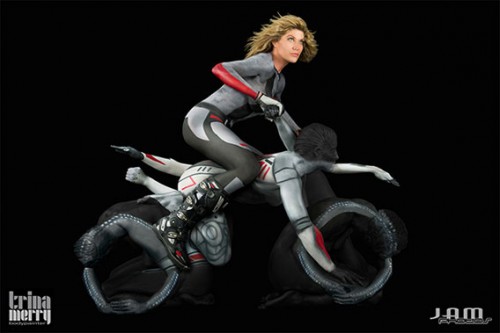

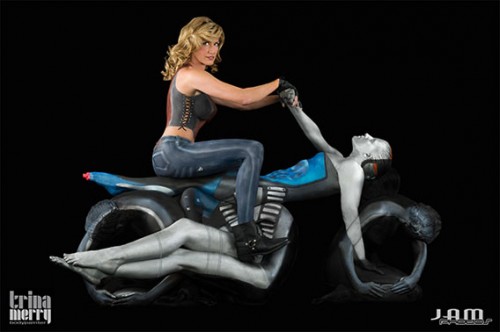
STC: When doing a project so extensive as the Human Motorcycle Project, how do you manage all those cast members, crew, and also be the body painter?
Trina Merry: I’ve had to learn when to step back and take the role of the Art Director or Producer. Sometimes I’m just managing the project and jumping in to fill the gaps that I see need filling when it is necessary. I read a lot of books about being an entrepreneur and time management. I talk to a lot of entrepreneurs about their techniques for getting things done in an efficient manner. I’ve learned to simplify and eliminate excess people from my sets. The need for more communication with more people means taking up more time. I keep it as simple as possible.
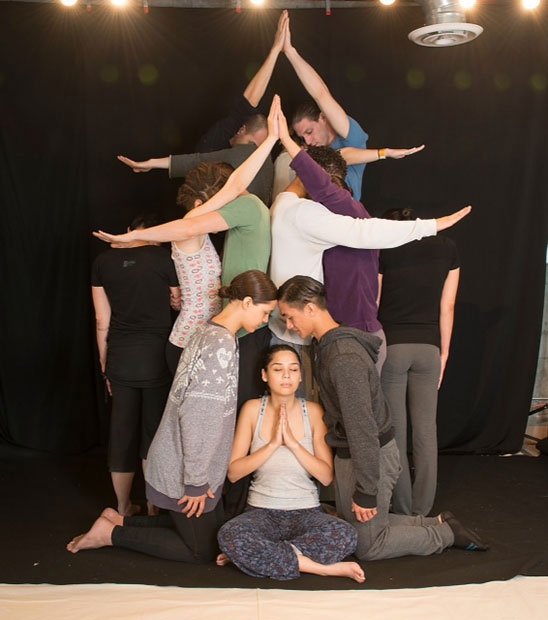

STC: An 18-hour day sounds exhausting for the models. Obviously they can’t hold a pose that long. How do you manage the physical demands for them?
Trina Merry: No, they’re not holding the pose for 18 hours. I’ve had to learn techniques for dealing with human physiology. Breathing and mental focus are so important. If the model is inexperienced with focus or being internally silent then I have to hypnotize them with movies, music, or food. [Laughing] The model I worked with today, for example, was new to me. I knew it was going to be an uncomfortable pose but I was able to distract her with a laptop playing movies.
STC: As physically demanding as these poses are, it must be difficult to find models that can do this kind of work. Do you tend to hire the same models over and over?
Trina Merry: Yes. I tend to work as much as possible with the same people. It’s so difficult to find dependable people. And it’s not just finding those who I can count on to show up but those I can depend on to be able to perform this kind of work. I have a network that is a sisterhood. The respect and trust I have for them and they have for me is a very tight bond. Some of these models will literally go the extra mile for me—I’ve had them offer to fly across the country to help me out when I needed it. I have to honor that. When I’m experimenting with a new idea, it’s much easier to work with people I know and trust rather than having to explain Body Painting 101 to someone new.
While working under body painter Craig Tracy (her teacher and mentor), Merry also helped to create photos of the Fiat 500 out of bodies:
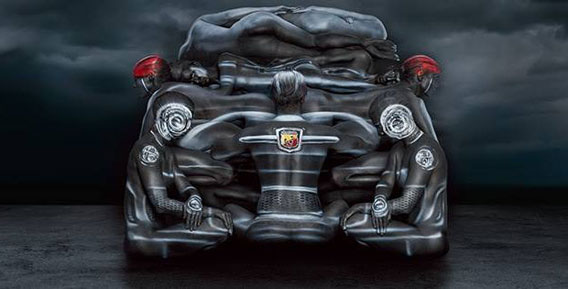

Here’s a behind-the-scenes vid for that series, which appeared in ESPN’s 2013
STC: Do you have a piece of work you feel is your favorite or the best you’ve done?
Trina Merry: I approach each experience with the hope that it will be a fresh one for me. On each project, I tend to feel it’s the best one I’ve done so far. I’m always learning something new. Some are complex puzzles of how to pose multiple models and some are how to best camouflage the model into my background. The emotional process happens in the pre-production but the relationships with the model and crew and the constant problem solving that takes place is what leaves me exhausted yet totally satisfied. The next morning following a session, I am so sore. It’s very physically demanding and painful to body paint. I’ve had to incorporate yoga into my life in order to strengthen my body. The day after that day though, I’m usually feeling great and thinking, “OK! What’s next?” I’ve had to change the way I eat as well so I can stay fit enough to do the job. It’s the difference between having a career that lasts 5-10 years and one that can last 30.
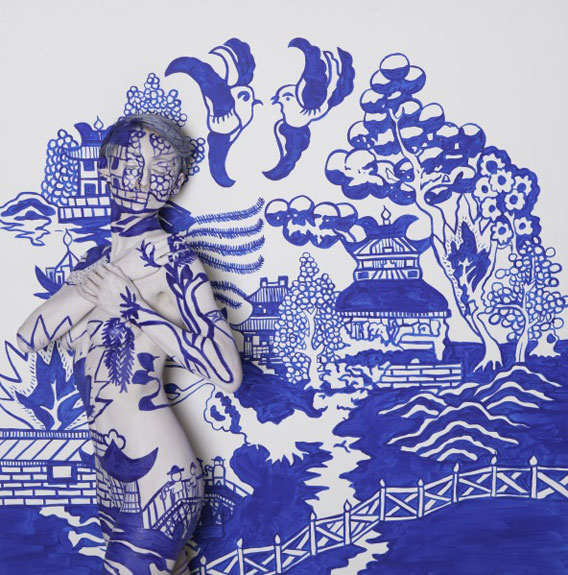
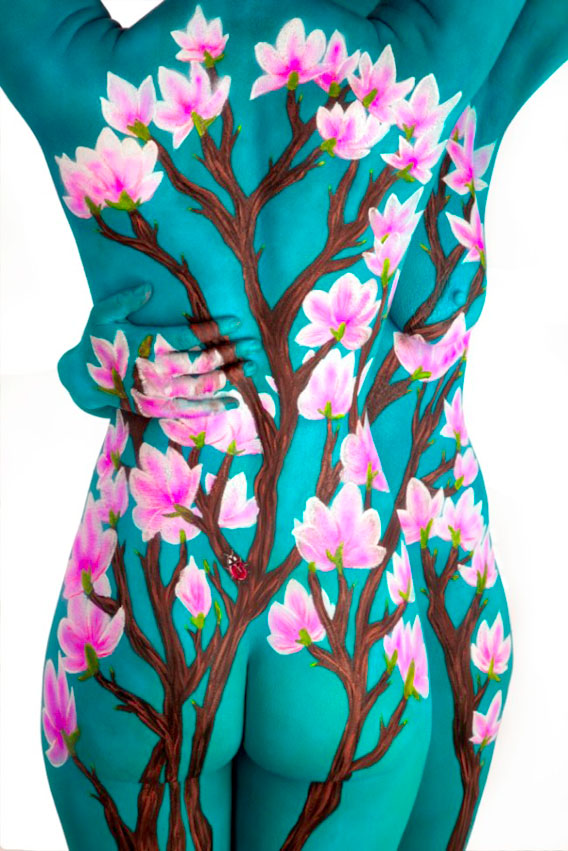
STC: I read an interview with you where you said the photography of your work is something you’re thinking about from the onset of the idea. Can you explain a little about this method?
Trina Merry: It’s awkward to admit but most times I’ll mark a spot on the floor with tape and say, “Put the tripod there” and I’ll adjust the camera to my eye-level. I feel bad because I give the photographer no room for creativity but with this type of work, the perspective is very specific. I know exactly what I want and I can’t give them any leeway. It takes a very special photographer who is humble enough to handle this. With the digital age, photographers take picture after picture and end up with many images to choose from. With body painting, we’re trying to get just one shot. That’s it. As exhausting as it is to add one more job to my plate during these projects, I know exactly what I’m looking for so it’s just easier to do it myself most days. During the day, I’ll have a tethered camera locked down on a tripod and I’ll take photos to ensure everything is lining up right and looking the right way but ultimately I’m just trying to get that one shot because it only looks right from that one perspective.. Like we aspired to do in when I worked in film, get it done in one take. When we’re done, we’re done!

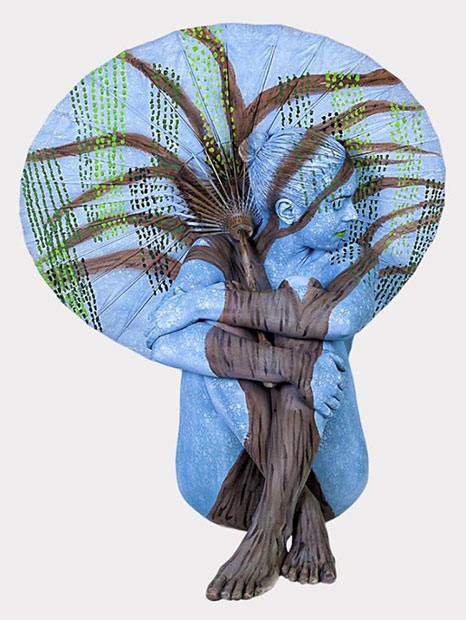
STC: As an educational company focused on photography, we have many fans who are obsessed with lighting techniques. Are there any specific lighting ideas you keep in mind when working with a photographer (or shooting it yourself)?
Trina Merry: Yes. Unlike many other styles of photography, the nature of this work necessitates a very basic light setup. The light needs to be as flat as possible with no hot spots and no shadows. We’ll either use one really giant light from the back behind the camera or two even lights on either side in front. When you have 17 models, it does become quite a challenge to eliminate the hot spots and shadows.
STC: You did a project today so you’ll be sore tomorrow. But what’s next the day after that?
Trina Merry: I’m working on a few projects. One is a personal project that is a series about subways. I’ve been commissioned to do a calendar and an ad campaign for Gordon Biersch. Another project focuses on the seven deadly sins. I have a show coming up in June in San Jose and I’m showcasing at the World Body Painting Festival in Austria. I have two other installations and one other performance scheduled.
STC: So you’re staying busy.
Trina Merry: [Laughs] Yes but I was just talking to my agent and saying, “I need more work!”
STC: Thank you so much for taking the time today to talk to us and give us some insight into your incredible work and the process it takes to make it happen. Is there anything else you’d like to say to our readers?
Trina Merry: It’s important that when you’re dealing with the female form especially the nude female form, that you elevate it above just sexuality. This is especially important for people with body issues, Daddy issues, etc. Make it more about the beauty and art of the form instead of just focusing on the sexual aspect. Thank you.
You can see more of Trina Merry’s work on her website
http://www.trinamerry.com and go Like her Facebook page www.facebook.com/MerryBodypaintings, Interview by STC attendee Doug Hill.

© 2014 Copyright ShootTheCenterfold.com. All rights reserved.





